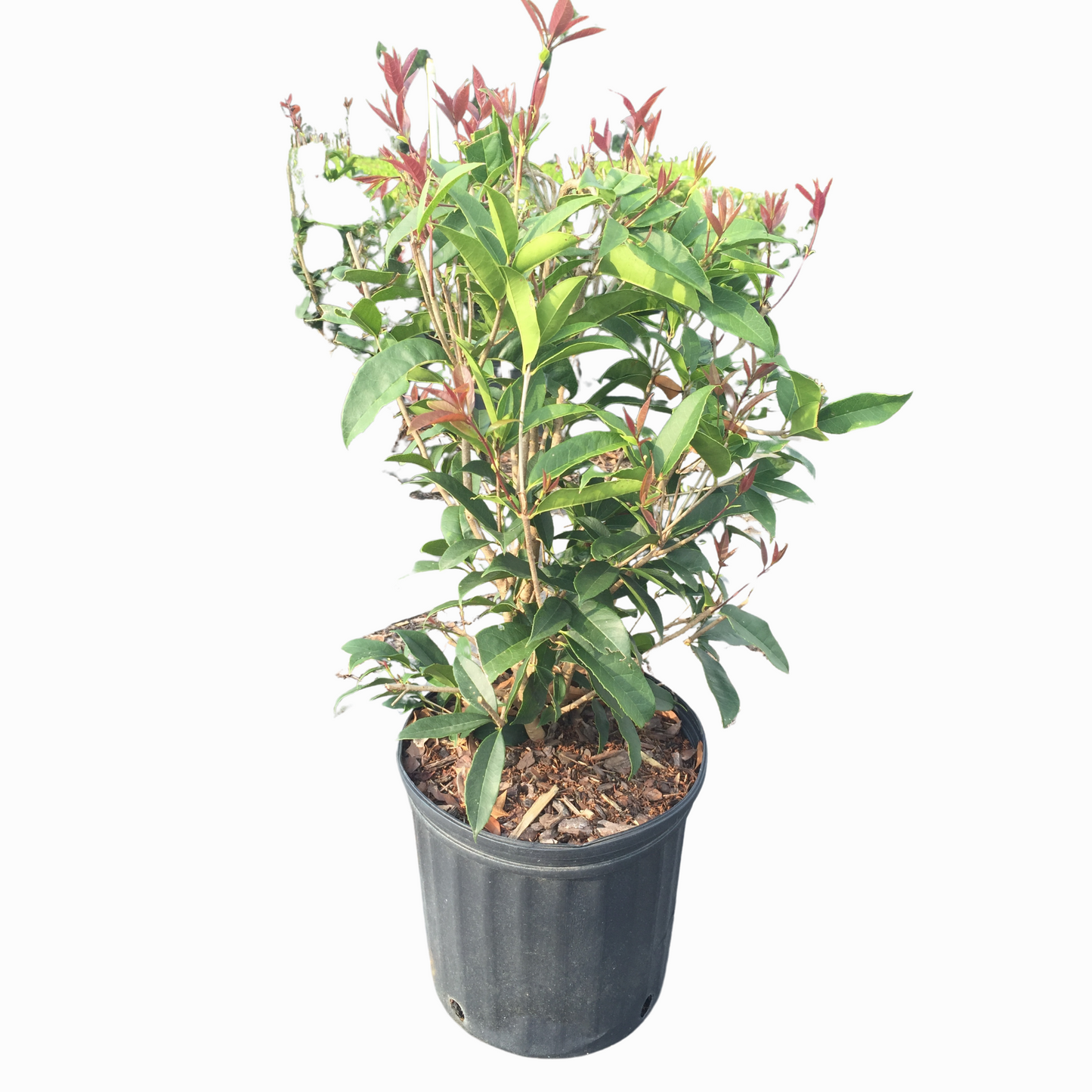Sweet Olive Plant
Sweet Olive Plant
4.23 / 5.0
(22) 22 total reviews
Couldn't load pickup availability
![]() Get it between -
Get it between -
Description
Description
As large as it is lovely, at an incredible maximum size of 20 feet tall and 6-8 feet wide you’ll want to make sure to plant the Sweet Olive evergreen shrub only where it’s capable of growing to its full potential. Though it prefers at least somewhat fertile soil, the Sweet Olive Osmanthus shrub is adaptable to living in much worse conditions with poor soil and can thrive even with general neglect. Offering an incredible fragrance that you’re going to want to enjoy, planting these shrubs near doors and windows is a great way to enjoy them all day long. For the best results from your Sweet Olive plant just place it in full sun to partial shade in moist to average soil. Great in a row or as part of a hedge, this lovely shrub is covered in small white flowers through Fall, Winter and early Spring, with occasional blooms in the Summer as well.
Shipping & Returns
Shipping & Returns
Shipping:
Shipping live plants sometimes has its challenges when dealing with inclement weather but we strive to have every single order shipped out on their scheduled shipping date. Most orders will be scheduled to ship within 1-2 weeks of ordering. Because a plant needs TLC we only ship out on Mondays-Wednesdays to ensure the plants aren’t stationed somewhere over the weekend with no water or sunlight.
When to Ship:
We can ship out plants at anytime of the year pruned or not pruned, cold or not cold. Each plant’s durabilty is different so we recommend having them shipped in their designated season but we will still ship your plant to you earlier if you choose so.
Returns:
Because plants are perishable they cannot be returned without prior permission. We work hard to ensure all plants arrive healthy, but on rare occasions issues with the plant health upon delivery do arise.
Every single shipped plant is healthy upon departing our facility but if a plant is received in poor health contact us immediately so that we can assess the problem and work on saving the plant. We will first need a photo of the plant to start a claim. If we determine your plant cannot be recovered we will send you a replacement immediately. If notified of the plants health within 4 days we will send a replacement 100% free of charge.
If you determine the plant not to be healthy 4 days after delivery you can contact us and we will issue a 50% store credit.
30 days after delivery we cannot be held responsible for the current health of the plant.
Wholesale & Bulk Orders
Wholesale & Bulk Orders
To get started or learn more about our wholesale program and pricing please complete this form.










Questions & Answers
Have a Question?
-
Can small leaf tea olive be grown in large 10 gal container?
Yes, we have grown them in 7 and 10 gallon containers.
-
Do I need to prune? When? How much?
Pruning a sweet olive plant is optional but helps maintain its shape and size. Prune in late winter or early spring before new growth begins. Remove up to one-third of its growth, focusing on dead, damaged, or overgrown branches.
-
Will a sweet olive tree grow in the Houston tx area?
Yes, a sweet olive tree (Osmanthus fragrans) will grow well in the Houston, TX area. It thrives in USDA Zones 8-10, and Houston’s climate is suitable for this fragrant, evergreen tree.
-
Can u take a cutting off bush and replant?
Yes, you can take a cutting of a sweet olive (Osmanthus fragrans) and propagate it. Use a semi-hardwood cutting from the plant, typically in late summer or early fall. Dip the cut end in rooting hormone, plant it in a well-draining potting mix, and keep it in a humid environment with indirect light. Rooting can take a few weeks to a couple of months.
-
Is it good in zones 4 to 5
No, sweet olive (Osmanthus fragrans) is not cold-hardy in zones 4 to 5. It thrives in zones 8 to 11.
-
Can Sweet olive plants grow in New York area? Zone 6. Thanks.
Sweet olive (Osmanthus fragrans) is typically hardy in USDA Zones 7-10, so it may struggle to survive in Zone 6 (New York area) during cold winters. It could be grown in a pot and brought indoors during the winter to protect it from freezing temperatures.
-
can I pay by visa?
Yes!
-
How deep to plant in the ground and what type of fertilizer to use?
Plant at the same depth as the root ball, ensuring the top is level with the soil surface. Use a balanced, slow-release fertilizer like 10-10-10 in spring.
-
Zone??
Sweet Olive plants (Osmanthus fragrans) are best suited for USDA hardiness zones 7 to 10. They thrive in warm climates and can tolerate mild winters. In these zones, Sweet Olive plants can grow well outdoors and produce their fragrant blooms, especially in warmer areas where the temperatures don't drop too low.
-
What the hardness zone can it grow?
Sweet olive (Osmanthus fragrans) is hardy in zones 7-10.
-
Is the Sweet Olive shrub winter hardy? Lucy
Winter hardy in USDA zones 8-11.
-
Can the sweet olive be planted in pots
Yes, it grows well in containers with proper drainage.
-
What is it’s rate of growth?
Slow to moderate, around 4-12 inches per year.
-
How to prune or trim!
Lightly prune in early spring to shape and encourage growth.
-
What is the grow rate
Slow to moderate, around 4-12 inches per year.
-
What planting zone can this sweet olive be grown in?
Sweet Olive plants (Osmanthus fragrans) are best suited for USDA hardiness zones 7 to 10. These zones provide the mild winters and warm climates that Sweet Olive thrives in, making it ideal for areas with moderate temperatures throughout the year.
-
Is this fast growing?
It grows moderately fast, about 12–24 inches per year.
-
Is it deciduous?
No, sweet olive (Osmanthus fragrans) is evergreen.
-
when does sweet olive boom
Sweet olive (Osmanthus fragrans) blooms in spring and fall, sometimes year-round in warm zones.
-
I am living in lower NY zone 7b. Would you think sweet olive can survive?
Marginally; may need protection in cold winters.
-
What are the sweet olive tree sizes of the 1 gal and 3 gal respectively?
the one gallons are currently still growing, however, the 3 gallons are 31 inches tall and 23 inches wide.
-
how tall and wide do sweet olive get
Typically 10–20 feet tall and 6–10 feet wide.
-
Hello, just purchased a 7 gallon plant, how tall is it when it ships?
Hi! The 7g sweet olives, on average, are about 28 inches tall and 18 inches wide.
-
Shade or sun?
It prefers full sun to partial shade.
-
Is this safe for dogs
Yes, the sweet olive plant (Osmanthus fragrans) is considered non-toxic to dogs. However, it’s always a good idea to monitor pets around plants to ensure they don’t ingest large amounts, which could potentially cause minor digestive upset.
-
May I know what is the color of the flower?
It blooms white.
-
Does Sweet Olive shrubs like shade.
Sweet Olive shrubs (Osmanthus fragrans) prefer full sun to partial shade, but they can tolerate some shade. For optimal growth and fragrant blooms, it's best to plant them in a location with at least 4 to 6 hours of sunlight daily. While they can grow in shadier spots, too much shade may reduce flowering. Sweet Olive shrubs thrive in well-draining soil and are known for their highly fragrant flowers, making them a great addition to both sunlit and partially shaded areas of the garden.
-
How far apart should I plant them to form a privacy hedge?
To create a privacy hedge with Sweet Olive shrubs (Osmanthus fragrans), plant them 4 to 6 feet apart. This spacing allows enough room for the shrubs to grow while providing dense coverage as they mature. Sweet Olive plants can reach heights of 10 to 12 feet, making them an excellent choice for a tall, fragrant hedge. Ensure they are planted in well-draining soil and receive full sun to partial shade for optimal growth. Regular watering will help them establish and thrive as a privacy barrier.
-
Will it grow in Indiana, zone 5
No, a Sweet Olive plant (Osmanthus fragrans) will not survive in Zone 5 Indiana, as it thrives in USDA Zones 8 to 11. Sweet Olive is sensitive to cold and cannot tolerate freezing temperatures common in Zone 5 winters. In colder climates like Indiana, it’s best to grow Sweet Olive in containers that can be brought indoors during the winter months or consider other cold-hardy plants better suited for your zone.
-
Does this tree produce olives that you can eat ? How tall are these trees?
The Sweet Olive plant (Osmanthus fragrans) does not produce edible olives, despite its name. Instead, it is known for its fragrant, small white flowers that emit a delightful scent. Sweet Olive plants can grow up to 10 to 20 feet tall, making them ideal for use as hedges or ornamental shrubs.
-
Is it deer resistant?
Yes, the Sweet Olive plant (Osmanthus fragrans) is considered deer-resistant. Its tough, leathery leaves and strong fragrance typically deter deer from grazing on it, making it a great choice for landscapes where deer are common. This evergreen shrub also adds a lovely fragrance to your garden, especially when it blooms. It thrives in USDA zones 8-11.
-
Do these fruit? I am looking for the Elaeagnus Umbellata. Is this it?
We grow the fruitlandii elaeagnus. They do fruit, however, they are not edible. The fruitlandii plant produces small brown fruit in the late fall.
-
What zone will this grow?
The Sweet Olive plant (Osmanthus fragrans) thrives in USDA zones 7 to 10. It prefers warmer climates but can tolerate some colder temperatures in the lower end of this range. In colder zones, it may need protection during harsh winters.
-
I live in Michigan, will it grow in our back swampy soil?
Sweet olive plants (Osmanthus fragrans) prefer well-drained soil and may struggle in consistently swampy or waterlogged conditions. They thrive in soils that are slightly acidic to neutral and appreciate good drainage. If your back area is swampy, it may lead to root rot or other water-related issues. To improve success, consider planting them in raised beds or improving drainage in the area.
-
Can the sweet olive grow in Rapid City South Dakota🤔
Sweet Olive plants (Osmanthus fragrans) are typically hardy in USDA zones 8-11, meaning they thrive in warmer climates. Unfortunately, Rapid City, South Dakota, falls in USDA zone 5, which experiences much colder temperatures. Sweet Olive plants are unlikely to survive the harsh winters of zone 5, as they are not cold-tolerant enough to endure freezing temperatures typical of the area. You might be able to grow Sweet Olive in a container and bring it indoors during the colder months, but it is not suited for outdoor growth year-round in Rapid City.
-
I have a very small sweet olive, should I keep it in a pot for another season or put it in the ground this fall? It did not do very well indoors. I live in West Tennessee
Since you’re in West Tennessee, it’s best to plant your sweet olive (Osmanthus fragrans) in the ground this fall for stronger root establishment before winter. Potted sweet olives may struggle indoors, while in-ground plants are more resilient in cold weather.
-
When is the best time to plant sweet olive tree in zone 7 in Mississippi
The best time to plant a sweet olive tree (Osmanthus fragrans) in zone 7 is in early spring or fall. Planting during these seasons allows roots to establish before summer heat or winter cold, leading to stronger growth.
-
Should I ever add any fertilizer to my sweet olive shrubs?r
Yes, fertilizing sweet olive shrubs can support healthy growth and encourage fragrant blooms. The best time to fertilize is in early spring, just as new growth begins. Use a balanced, slow-release fertilizer (like a 10-10-10 formula) and apply it according to package instructions. You can also add a light dose in late summer to support ongoing growth, but avoid fertilizing in fall, as it may stimulate growth that’s vulnerable to winter cold.
Tip: Mulching around the base can help retain moisture and regulate soil temperature, benefiting the roots without competing with fertilizer.
-
Does this plant give fruits?
Yes, a sweet olive can produce small, non-edible fruits after flowering, but the plant is primarily grown for its fragrant blooms.
-
What is the root system like. How far from house and plumbing should sweet olive tree be planted?
Sweet olive trees (Osmanthus fragrans) have a non-invasive, shallow root system. However, they can spread laterally as the tree matures.
Planting Recommendations:
- Distance from the house: Plant at least 3–5 feet away to allow for canopy growth and airflow.
- Distance from plumbing: Keep at least 10 feet away to avoid potential interference with underground pipes.
Sweet olives are low-risk for root damage but need adequate space to grow healthily.
-
Is this the same as a tea olive?
Yes, sweet olive and tea olive are both common names for Osmanthus fragrans.
-
what osmanthus can I buy that is in a 7 gallon container but grows approx 12 feet
You can choose Osmanthus fragrans, which grows to about 12 feet tall.
-
Will it ( the sweet olive) survive in western facing north Florida sun?
Yes, sweet olive can tolerate western sun in North Florida but benefits from some afternoon shade.
-
It got very cold south of Dallas Texas. My sweet olive shrubs lost most of its leaves. Is it dead ? Can it regrow and survive?
Your sweet olive shrubs may not be dead. Sweet olives can lose leaves after a cold snap, but their roots are often resilient. Check for life by scratching the bark; if it's green underneath, the plant is still alive. Prune any damaged branches in early spring and wait for regrowth as the weather warms. Mulch around the base to protect roots in future cold spells.
-
what is the hardy zone?
Sweet olive is hardy in zones 8-11.
-
Will they do ok in zone 5
No, they are not cold-hardy enough for zone 5.
One of the plant was fine, the other one look like someone sat on it. But, I planted both since the roots are alive.
I WOULD LIKE TO HAVE A DISCOUNT TO MY PURCHASE!!
might of been more on fedex delaying delivery ,the plants were completely dried out , the leaves looked like they had blight . but i still put them in the ground they are pretty hardy plants .
The plant shipped to us was large and well packed. It looked healthy. We have planted into the yard and hope it will survive in NY. Recommend Michael's Nursery!!
Arrived healthy
I ordered a 7 gallon sweet olive tree and when it arrived it was approximately 18 inches tall... a lot smaller than I anticipated











